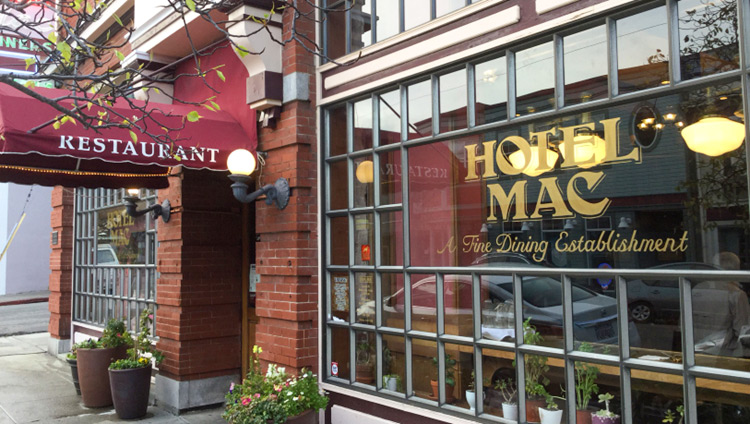The Hotel Mac, originally the Colonial Hotel, was constructed in 1911 by entrepreneur Kate Riordan, an Irish immigrant, who had been running the St. James Hotel on Cottage Avenue after fleeing San Francisco following the 1906 earthquake. Richmond was in a growth spurt at the time, and hotels, restaurants, bars and boarding houses were in demand by refinery and railroad employees.
The architect was C.O Clausen, uncle of the late Richmond engineer Bert Clausen, and the construction cost was $25,000. The hotel had 30 rooms, typically small and intended for single men.
Although the 20th Amendment was not passed until 1920, California adopted full voting privileges for women in 1911, and Kathryn (Kate) Theresa Riordan was the first woman in Contra Costa County to register as a citizen and as an unmarried woman with rights and privileges to vote.
The Colonial Hotel opened in September 1911, and Kate Riordan gave a banquet for 30 city officials to celebrate the occasion.
With one voice all present expressed their praise of the efforts of the most successful young businesswoman that the giant among the newer cities of the Golden gate had produced … and drank a toast to her personal worth … her success and in appreciation of her efforts.
In 1914, Kate Riordan married James Pope, “well-known Standard oil employee.” They had seven children who lived with them at the Colonial. In 1926, they traded the Colonial for a dairy ranch in Modesto and moved their big family to the country. “A culture shock,” one of their daughters, Elizabeth Pope of Berkeley, remembered, but one they adapted to happily.
The Colonial passed through two owners, E.D. Hanford and Harry and Lula Moore. In the late 1930s, it was bought by J.V. McAfee, former manager of the Claremont Hotel, who changed the name to “Hotel Mac.” McAfee made the Hotel Mac restaurant a popular destination, and it was listed by Duncan Hines as an exceptional eating place.
During the years of WWII, the onslaught of shipyard workers looking for fast and cheap eats brought an end to fine dining. Those who knew him said McAfee lost heart, and he sold the building in the late 1940s. A series of ensuing managers failed to resurrect its former glory. The elegant façade was closed over and the interior “modernized,” making it look like any one of a hundred other nondescript dark bars.
In 1971, two fires did extensive damage to the top floor and roof. The bar had already been closed by owner John Nunez for “remodeling.”
Nunez then sold the building to Point Richmond real estate operator Hazel Carr, who had the roof structure replaced, but further work bogged down due to lack of funding. The building was condemned by the City of Richmond, and demolition was imminent.
In 1977, the building went into foreclosure, and Jim and Darlene Byers and Tom and Shirley Butt hatched a plan to save it. “We attended the foreclosure sale on the courthouse steps,” recalls Tom Butt, “and the bidding started with only one competitor, H.J. Shiells and Richard Burke. It quickly rose to $39,000. Byers pulled the plug, and the competing bidder went home with the deed to the Hotel Mac for $39,000.” “That guy is just a flipper,” Byers told me. “He’ll be calling in a couple of days.” “If we had continued to bid,” said Byers, “ the price might have gone to $50,000, or more.”
Jim was right. Two days later the new owner of the Hotel Mac called, and we negotiated a purchase for $43,000. The Byers owned 75%, and we owned 25%. The building was a mess, and the first job was to lift the condemnation order. The next was to rehabilitee the building shell.
Design of the structural work for seismic bracing was already started by Clausen Engineers, who had designed the roof repair for Hazel Carr and then completed by a structural engineer who left Clausen to start his own business. I (Tom Butt) provided architecture and construction management for the shell rehabilitation through Interactive Resources, Inc..
Money was as tight. Point Richmond, which was pretty rough around the edges then, didn’t have any track record for successful real estate ventures. The famous Point Richmond Fourth of July riot was a recent memory for many. The village was virtually dead with people living in storefronts and Hell’s Angels routinely descending on the town to patronize the local bars. On any given Sunday, you might see hundreds of Harleys parked from Tewksbury (which was then the main highway) to West Richmond Avenue. Bar patrons spilling out into the street to settle differences was common.
We had to keep the construction cost down, and one way of doing it was to apply for Federal Historic Preservation Tax Incentives, which then consisted only of accelerated depreciation. But anything would help. I looked into getting the Mac onto the National Register of Historic Places so it would qualify, but it was not significant enough as an individual building. However, Caltrans had recently conducted a National Register eligibility study for Point Richmond as a historic district in conjunction with planned improvements that preceded but eventually became a part of I-580. The State Office of Historic Preservation had deemed Point Richmond “eligible” as a district.
Knowing the outcome would be positive, I recruited Lucretia Edwards and several other neighbors to help inventory the buildings and prepare a formal National Register application. We were successful, and Point Richmond Historic District was entered on the National Register in 1978. The Hotel Mac was listed as a “contributing structure,” along with some 330 others. We were in!

